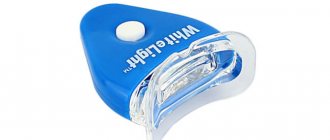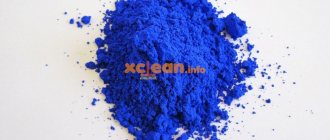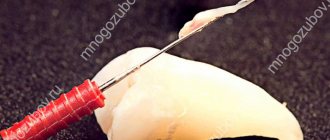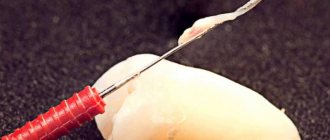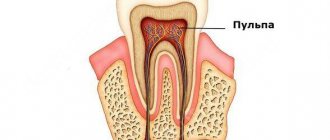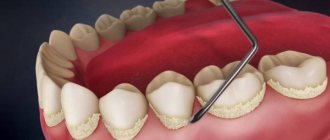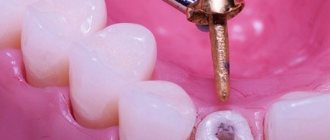- Features of installing a temporary filling
- Why can a temporary filling fall out?
- What to do when a filling falls out
- If the filling falls out on the day of installation
- Loss of filling in sealed and unsealed canals
Temporary fillings are made from composites. Its installation is necessary to seal and protect the tooth cavity during the treatment period. The main task is to prevent the penetration of pathological microorganisms and remnants of food consumed by the patient into the dental canals. Unlike composites, which are fixed after treatment is completed, such a filling can be removed to continue dental procedures. Insufficient fixation can lead to a piece of composite falling out on its own. In order not to provoke complications or damage to the internal cavity of the tooth, you need to know what to do if a temporary filling falls out.
Is it possible to remove arsenic or a temporary filling from a tooth on your own at home?
In modern dentistry, arsenic is used quite rarely. However, in some cases, the use of this toxic substance is the only way to cope with toothache. After removing the old filling and placing arsenic paste into the cavity of the diseased tooth, a temporary filling is installed so that the pulp killing agent holds well and does not enter the patient’s body. The dentist extracts the arsenic after a certain time. However, sometimes it becomes necessary to remove it yourself. In this case, you need to follow the rules, otherwise you can only do harm.
Temporary dental filling: all the nuances
After having a filling installed, patients are often interested in when they can eat. It depends on the type of filling. Typically, dentists advise not to eat for an hour or two.
When using dentin paste, it may take about 3 hours to cure, but light-curing cements can tolerate food almost immediately. If you do not want staining of the cement to occur, do not consume food or drinks that are colored.
How long you need to wear a temporary filling depends on the reason for its installation. If a seal was placed to isolate the medication, it will be removed immediately upon completion of treatment. Usually it is placed for a period of one day to one month.
In what cases may it be necessary to independently remove arsenic or a filling?
Arsenic is used when it is necessary to kill the nerve in order to eliminate painful sensations in the tooth. This toxic substance is used in doses sufficient to affect the nerve endings and tissues of the dental system, but safe for the patient’s health if a number of conditions are met. These include:
- exclusion of contraindications to the use of the drug;
- installing a temporary filling over the poison placed in the cavity of the affected tooth;
- strict adherence to the residence time of arsenic in a dental unit.
This toxic substance is highly toxic. If it is not obtained in time, serious complications may develop. Possible consequences of leaving arsenic in the tooth cavity for too long (more than 7 days) include:
- inflammatory processes in soft dental tissues;
- pulp swelling;
- darkening of the enamel;
- drug-induced periodontitis;
- severe damage to the periosteum and bone;
- development of pathological processes in neighboring teeth.
In addition, if the toxic substance is not removed for too long, intoxication of the body can occur.
Sometimes unforeseen situations arise when, for some reason, it is not possible to remove a temporary filling and remove arsenic in a dental clinic. In such cases, the only way out is to remove the toxic substance yourself, and you will first have to pick out the filling material.
In addition to observing the timing of the arsenic paste in the tooth, you should monitor your well-being. If pain occurs, you must immediately remove the substance. After extraction, in any case, you need to see a doctor for further treatment.
How to relieve pain?
If you followed all the doctor’s recommendations, but the tooth under the temporary filling hurts again, the following tips may help you:
- avoid contact of food and drinks, especially very hot or cold ones, on the side of the diseased tooth;
- periodically rinse your mouth with soothing infusions of sage, chamomile and mint and a disinfectant solution of salt and soda;
- Inspect the soft tissue surrounding the tooth as often as possible in order to identify the possible onset of an inflammatory process or suppuration. At the slightest hint of swelling or redness of the gums, call your dentist immediately;
- a cotton wool soaked in tincture of valerian and lemon balm and applied to a sore tooth will help temporarily relieve irritation and soothe pain;
- There are also special preparations (drops, gels) designed to relieve toothache, however, before using them, you should consult a specialist.
If your dentist feels there is no cause for concern, try to endure the painful period so as not to interrupt the treatment process. Unfortunately, any inflammatory process is accompanied by unpleasant sensations. It’s better to have pain under a temporary filling than to have to redo a permanent one later.
How to get rid of arsenic?
Before placing arsenic, the old seal is removed and a new one is installed to seal the toxic substance. Since a soft filling material is used in this case, the temporary filling may fall out prematurely. If it is not possible to immediately consult a doctor, the arsenic paste should be removed independently as quickly as possible. Arsenic is removed as follows:
- Teeth are thoroughly cleaned of plaque.
- Hands are washed with soap. Their disinfection with an antiseptic is a mandatory step in preparation for the procedure. For this purpose, you can use any alcohol-containing drink. If you don’t have vodka or alcohol at home, you can use a solution of potassium permanganate.
- Small tweezers or a needle are treated with an antiseptic.
- Using one of the instruments, arsenic is removed from the dental cavity. You need to act as carefully as possible, without violating the integrity of the substance. For convenience, it is recommended to use a mirror. The workplace must be provided with good lighting.
- After the poison is completely eliminated, the oral cavity is rinsed with chamomile decoction, soda solution or an antiseptic.
- A piece of sterile cotton wool or gauze should be placed in the area from which the arsenic was extracted. This measure will avoid contact of food with the dead nerve.
While using arsenic paste, it is not recommended to plan long trips, so that if any painful symptoms occur, you can consult your doctor. Often, teeth that are treated with arsenic are subsequently destroyed, resulting in the need to restore them with a crown.
What are temporary fillings?
A temporary filling is created from a special material that does not dissolve in water. The composition of the filling substance and the material for its creation must be selected individually - it all depends on the patient’s diagnosis, as well as on the type and degree of damage to the patient’s tooth.
- Caries under filling
Dentine paste
This material is able to protect the tooth surface from staining with amalgams. It also has the property of repelling moisture, so this material is not used together with liquid medications. It hardens in about two hours, and you can wear such a filling from one week to ten days.
Dentine paste
Vinoxol
This material is very durable, which is why the integrity of such a filling can be maintained for up to six months. This material has antiseptic properties, so such fillings are placed if the cavity of the affected tooth needs to be disinfected. Hardens in about four hours.
Artificial dentin
Another name for this material is zinc sulfate cement. It is set for no more than seventy-two hours. Before installing an artificial dentin filling, the tooth cavity must be thoroughly dried so that the filling mass does not have contact with a humid environment: in this case, the material will not be able to harden.
Artificial dentin
Nice
This substance exists in white and pink colors. Such fillings are most often installed for the treatment of non-pulpless teeth. This filling is hypoallergenic and cannot irritate the oral mucosa.
Nice
Polycarboxylate cement
This material has quite high strength. Also, the mass is biocompatible, so such fillings are installed mainly on baby teeth. In addition, the mass is used for fixing dentures.
About polycarboxylate cement
Blend of oxide, zinc and eugenol
This mixture can not only effectively disinfect the patient’s oral cavity, but also have a sedative effect. This material has high resistance to any mechanical loads. Hardening of the mass occurs within twelve hours.
How to remove a temporary filling?
Patients often remove temporary fillings at home. Experts note that this is not recommended. However, it is better to remove the filling material and arsenic on your own than to delay the time it remains in the tooth cavity. Removing the seal looks like this:
- After brushing your teeth, you should thoroughly wash your hands and treat them with vodka, alcohol or potassium permanganate dissolved in water.
- The needle, tweezers or toothpick are disinfected.
- Looking in the mirror, you need to carefully pry off the filling with a needle, trying not to injure the gum tissue. The instrument should not be inserted too deeply to avoid pain.
- After removing the filling material, the arsenic paste is removed using the method described above.
- As in the previous case, the oral cavity is thoroughly rinsed with chamomile decoction, soda solution or any other means with a disinfecting effect. After this, the resulting depression in the tooth is closed with a piece of sterile cotton wool.
Read also: Medicines for toothache are quick and effective.
Don’t be afraid that you won’t be able to pick out a temporary filling. The filling material used in this case has a rather fragile structure, due to which it is easily destroyed under mechanical stress. The video below shows how to properly remove a temporary filling and the arsenic underneath.
Is it possible to remove caries at home?
Today we can confidently answer this question – yes. Initial carious lesions of tooth enamel can be stopped and even cured at home. Filling and removal are inevitable methods when caries has already penetrated under the enamel and reached the dental tissues, bones, and roots. But as long as the process develops on the surface of the enamel, it can be reversed.
Early stage caries can be cured at home
This is interesting. According to the research of the American doctor Price, who spent a long time studying the condition of the teeth of the indigenous peoples inhabiting the continent, it was found that, despite the lack of oral hygiene, these people did not suffer from caries. The doctor began to feed the subjects “Western” food that had undergone heat treatment and did not contain enough vitamins. Their teeth began to deteriorate as rapidly as those of the new Westerners.
Seven steps to getting rid of caries at home
A beautiful smile is the key to proper oral care
Step one
Limit or completely eliminate foods containing large amounts of phytic acid. This acid is the main chemical form in which phosphorus is found in foods. Its excess is found in traditionally healthy products known as suppliers of vegetable protein and fiber - grains, oilseeds, nuts, legumes.
Table of phytic acid content in foods
What happens when the body is oversaturated with phytic acid? Proper absorption of phosphorus is inhibited. This component also binds and stops absorbing calcium, zinc, iron and magnesium. These bound forms, called phytates, change the composition of the blood, making it less mineralized. To get the necessary minerals, the body begins to pull them from the dental and bone tissue. This leads to weakened teeth, which are easily affected by caries.
Phytic acid leads to tooth decay
Step two
You can call it remineralization. The goal is to quickly restore the lack of minerals in dental tissue. This is done by saturating the enamel from the outside, using toothpaste containing fluoride and a mouthwash that matches it in composition.
Parodontax toothpaste
In parallel with using fluoride-containing paste during the day, it is recommended to rinse your mouth with aqueous solutions of calcium and magnesium powders. This will not only saturate the enamel with minerals, but will also maintain an alkaline environment in the oral cavity, neutralizing the acidity that contributes to the occurrence of caries.
Use the mouthwash 2 times a day
Advice. Before you start using fluoridated toothpaste, check the drinking water chemistry in your area. If the water has a high fluoride content, its excess can pose a danger to the body, leading to hypervitaminosis.
Step three
Improve the quality of food. Give up processed foods and fast food in favor of healthy foods. Eat more vegetables. Do not overcook foods.
- Caries in the spot stage
Delicious and healthy vegetable salad
Step four
Take supplements. From food, no matter how fortified, mineralized, natural and organic it is, modern man cannot get all the nutrients he needs. This doesn't mean you can give up healthy foods. This only means that to help the body and saturate it with useful substances, you need to take vitamins and minerals in the form of supplements.
Ascorbinka
Fermented fish oil, vitamin D, ascorbic acid, calcium, magnesium - all this is no worse absorbed by the body from small tablets and capsules than from kilograms of food that you will have to digest to replenish the vitamin-mineral complex.
Fermented fish oil
Step five
Eat foods that restore teeth. Meat from organically raised animals, offal, seafood, natural fats and dairy products (we are not talking about powdered milk and synthetic cottage cheese). Vegetables, herbs, vegetable fats. All this will help restore the protection of teeth from caries.
Natural dairy products for dental health
Step six
Hygiene. Although Native Americans did not practice oral hygiene, modern people cannot do without it. Hygienic procedures must be carried out in the prescribed manner and according to a specific protocol. Fighting bacteria and keeping your mouth clean will significantly reduce the chances of tooth decay.
Oral hygiene
Step seven
Don't tolerate toothache, even if it doesn't bother you much.
- Apply rinses with salt (sea) water or soda solution.
- Place a drop of clove oil on a cotton swab and apply it to the sore spot.
Clove oil
- Apply the mummy to the tooth.
- Take Ibuprofen or take the painkiller you usually take in such situations.
Ibuprofen
- If the pain continues, go to the doctor.
When can you not perform the procedure at home?
Strictly speaking, arsenic paste should only be removed in a dental clinic. Carrying out this manipulation without the participation of a doctor can lead to undesirable consequences. The most likely problems that may arise during the arsenic extraction process include:
- injury to the gums with a needle or tweezers;
- infection in damaged soft tissues;
- violation of the integrity of the extracted piece of paste, as a result of which particles of a toxic substance, together with saliva, enter the gastrointestinal tract and cause various damage to internal organs.
To avoid having to remove arsenic at home, certain rules should be followed. To avoid destruction of the temporary filling, food should be chewed on the healthy side. It is not recommended to plan long trips while arsenic paste is in the tooth. Experts urge patients to treat their recommendations with maximum responsibility; only strict adherence to them will help prevent dangerous consequences.
How to get arsenic out of a tooth yourself
Before dentistry reached a high level of development, arsenic was very often used to remove dental nerves. Nowadays this practice is used very rarely, but has not been completely eliminated. There are cases when the patient, for certain reasons, cannot visit the dentist, but the period of action of arsenic is already quite long and it needs to be removed. In such cases, it is necessary to remove the substance from the tooth cavity yourself, as it is very harmful. You need to know how to remove a filling.
Arsenic in a tooth is usually a blue lump of paste
Why is arsenic used in dentistry?
In order to kill the nerve, the dentist can use arsenic in his work. This medication has a necrotic effect on the nerve, which leads to its death. It also has a toxic effect, which requires its short-term use.
In medical practice, the remedy is used to eliminate toothache, which is caused by an open nerve. This can occur as a result of caries, periodontitis, pulpitis and other dental problems.
Arsenic occupies number 33 in the Periodic Table and has another name - arsenum. It is a brittle non-metal substance with toxicity. It has an immunotoxic effect on the human body. A dangerous dosage is 5–50 mg, depending on the individual susceptibility of the body.
The element arsenic is a strong poison
Arsenic in the tooth should not last long.
When performing dental work, the substance falls into the tooth cavity, providing a necrotic effect on the nerve endings and pulp. As a result of this impact, the following processes occur:
- direct cytotoxic effect on cells;
- disruption of cellular respiration and their death;
- denaturation of protein pulp;
- cessation of blood supply to the pulp;
- blocking impulses from nerve endings.
As a result of such processes, the nerve completely dies and becomes insensitive.
The substance is used in the form of a paste, the main component of which is arsenic. As a rule, this is an anhydride: Septodont, Kaustinerv, Pulparsen, Caustitsin, etc.
Arsenic paste for dentistry
The composition of such drugs includes arsenic anhydride, which provides a necrotic effect, as well as a substance that has an anesthetic effect, which allows you to quickly cope with painful sensations. The latter include: novocaine, dicaine, lidocaine.
The components of the paste include substances that ensure the disinfection of dead pulp and the destruction of pathogenic microflora. This may be thymol, carbolic acid and others. Thanks to the astringent components, the diffusion of the main substance is slowed down, as well as the effect of the paste is prolonged.
Regardless of what type of paste is used, it should not remain in the tooth for a long time. Sometimes there are times when you need to get pasta at home. If a person removes a filling, you should try to immediately contact a dentist.
How to prevent the development of caries?
The best treatment for any disease is prevention. Therefore, instead of reminding yourself every time how to properly fill your teeth yourself or looking for a good specialist for this, it is better to try to prevent their further destruction. What can be done?
Nutrition. Natural foods should dominate the diet, and various sweets and flour products should be excluded. Particular attention should be paid to products high in fluoride and calcium. The temperature of food consumed should not be too high or low.
Taking proper care of your teeth
Hygiene. Disinfection of the oral cavity should be carried out after every meal. You shouldn’t limit yourself to just toothpaste and a brush, because using dental floss and mouthwash increases your chances of maintaining healthy teeth.
Installing a dental filling yourself at home is a good alternative to going to the dentist. However, it is important to remember that this method is not always possible. It is suitable only for the simplest cases of dental damage.
How long should arsenic remain in a tooth?
Installing arsenic takes a little time. The dentist performs the following actions:
- pulp opening;
- removal of damaged dentin;
- laying the paste;
- providing sealing using artificial dentin.
Previously, the substance was placed with a closed pulp, but now this practice is not used, as there is a possibility of pain and swelling. Arsenic, depending on which tooth is being treated, is set for the following period of time:
- single-rooted – 24 hours;
- the rest – 48 hours.
It is very important to visit a doctor on the day of your appointment, as prolonged exposure to the substance becomes dangerous.
Read also: Blood flows after tooth extraction, what to do
A temporary filling over arsenic has fallen out - you need to see a doctor urgently
Arsenic should not be kept for more than 62 hours.
There are substances that can be kept for up to two weeks, these include depulpin. It is necessary to clarify with a specialist which particular drug was used. If it is not possible to visit the dentist at the appointed time, you need to extract the substance yourself. You need to be very careful with arsenic so that it does not enter the gastrointestinal tract when extracted. You need to remove it yourself for certain reasons.
Why might you need to extract arsenic yourself?
Arsenic paste has a high toxicity rate. It needs to be taken out in time. If it remains in the tooth for more than a week, inflammation of the soft dental tissues and other negative processes develop, which include:
- swelling of the pulp;
- darkening of dentin;
- drug-induced periodontitis;
- death of the periosteum and bone;
- necrotic effect on adjacent teeth.
It is necessary to keep the substance for the prescribed time and not violate the terms of its withdrawal. Just in case, you need to know how to remove arsenic from a tooth yourself. With prolonged exposure to the paste, complete intoxication of the body can occur. And also negative phenomena can occur with an incorrectly calculated dose.
Due to such a high risk of adverse reactions, the drug is used very rarely, although it used to be quite common.
The patient should be attentive to the timing of use of arsenic paste and do not forget to visit a doctor. You need to know when to get the pasta. Despite its necrotic and analgesic effect, the substance located in the tooth can cause pain, which also requires its immediate removal.
A tooth with arsenic hurts - it needs to be removed
The causes of pain are the following:
- the substance does not kill nerve endings, since it is not concentrated enough;
- long duration of action of certain drugs;
- inflammation of tooth tissue;
- necrosis in the area of the periosteum or jawbone;
- substance intolerance;
- incorrectly inserted paste.
Any of these reasons causes pain, which should alert the patient and remove the substance. You need to immediately consult a doctor or, at first, get the paste yourself. When a person removes a substance himself, he must understand that subsequent treatment cannot be avoided.
Reasons for installing a filling
Installing such a filling allows the dentist to monitor the effectiveness of the therapy. The presence of a filling can be an indicator of whether all affected parts of the tooth have been removed and whether therapy needs to be repeated.
Important ! If, after the period of wearing the filling, the dental therapy has not yet been completed, in this case the doctor is obliged to exchange it for a new one and continue the therapy.
Thanks to a temporary filling, the doctor can control the treatment process
The most common reasons why a temporary filling is installed.
| Cause | Description |
| Therapy for deep caries | Even an experienced doctor in this case cannot be completely sure that all the affected tooth tissues have actually been removed. That is why, to be on the safe side, a specialist installs a temporary filling on the patient in order to later check the effectiveness of treatment and the tooth’s response to therapy, and in the absence of relapse of the disease, install a permanent filling on the tooth. |
| Removal of the nerve located deep in the tooth, or treatment of its inflammation | Inflammation of the nerves of the tooth is called pulpitis. When it occurs, an inflammatory process occurs in the nerve bundle located deep in the tooth. The nerve is necessary to connect the hard tissues of the tooth with the nervous and circulatory systems. If a patient has deep caries, then in the absence of treatment, the nerve of the tooth is also involved in the development of caries. This phenomenon is very dangerous for the patient, and it can not only cause unbearable pain, but also spread to nearby tissues. When treating pulpitis, the dental nerve is most often removed and after complete cleaning of the tooth, its cavity is closed with a temporary filling. After a few days, the patient must return for a second examination to the dentist, and if the specialist does not detect any complications, the temporary filling is removed and replaced with a permanent one. Until recently, nerve removal was carried out using a completely different method: the root canal of the tooth was cleaned and a small amount of arsenic was placed into the cavity. This substance was needed in order to burn out the affected nerve roots and later remove them without the use of local anesthesia. To completely burn out a nerve, arsenic had to act on it for several days, which is why, so that the substance could not poison the human body, a temporary filling was placed on top of it. At the moment, this method of tooth extraction is outdated and practically not used in dentistry. |
- What to do if a tooth hurts under a filling?
How to extract the substance yourself?
After the doctor places the arsenic paste, a filling is placed on top, which prevents it from falling out of the tooth cavity. Sometimes it falls out on its own, which requires immediate attention to the dentist.
Removing arsenic paste yourself is dangerous. In addition, if you open the filling, the pain may only intensify. If the pain has stopped and the prescribed period of wearing the substance has expired, you can still try to remove it, if it is not possible to visit a specialist. There are certain steps that need to be taken.
- Brush your teeth well.
- Wash your hands with soap and treat with an antiseptic.
- Prepare a tool: a syringe or sewing needle, thin tweezers, and a toothpick will do. The item must be treated with an antiseptic. You can use alcohol, vodka, and potassium permanganate solution.
- Stand in front of the mirror and lightly pick up the filling without touching the gums. Do not insert the needle too deeply, as this may cause pain.
- After removing the filling, you need to try to get the substance out so that it does not crumble in the oral cavity.
- After completely cleaning the tooth from the drug, you need to rinse your mouth with an antiseptic or chamomile infusion.
A visit to the dentist for dental cleaning and treatment is mandatory.
Many people ask: if I remove the substance itself, what will happen. Nothing fatal will happen, but further treatment cannot be avoided. After arsenic has been removed, you should consult a doctor as soon as possible, since during the period of its action, the walls of the tooth have become thin, like its other parts, which can lead to its rapid destruction.
It is recommended not to plan long trips if arsenic has been detected, so that at the first appearance of negative symptoms you can consult a specialist. And it is also better to choose a method of treating dental nerves that does not use such a substance.
Very often, teeth that are treated with arsenic paste quickly crumble, which requires the installation of a crown.
Removing arsenic is very simple, but the consequences after it are very costly and long-lasting. You need to constantly visit the dentist to avoid moments when the tooth can no longer be saved except with the help of arsenic paste. It is recommended to use a good toothpaste that protects against caries.
What to do?
Of course, you need to see a dentist. But the patient does not always have the opportunity to urgently leave work. In addition, many people believe that there is nothing wrong with a filling falling out and are in no hurry to visit the dentist.
When the doctor places a filling, he notifies the patient about what materials are used and for how long it is installed. It is important to remember this, because if the doctor used arsenic-based paste to kill the nerves, then one should not hesitate in case of material loss. This substance is poisonous! If it gets on the mucous membrane, it causes a burn, and if swallowed, it causes poisoning, gastrointestinal upset, and the development of an allergic reaction.
Therefore, if the patient notices a hole in the tooth, he needs to thoroughly rinse the oral cavity with a soda solution (dissolve 1 teaspoon of soda in 1 glass of warm boiled water and add a few drops of iodine). After this, you need to cover the hole with a sterile gauze swab and go to the doctor.
If the dentist filled the canals and installed a temporary filling, but it fell out, this is not so dangerous. After all, there is no toxic substance inside the tooth and infection will no longer penetrate into the canals. But you still need to visit a dentist to solve the problem. The doctor will conduct an examination and decide what to do - put a temporary filling again or replace it with a permanent one.
We recommend remembering the following algorithm of actions:
- If the filling falls out while eating, it is better to spit out the chewed food. After this, you need to rinse your mouth with an antiseptic (Chlorhexidine, Miramistin) or a soda solution. If you don't have this on hand, you can use mouthwash or clean water.
- You should not try to close the hole with chewing gum or other improvised means, or pick out the remnants of the filling material. There is a risk of damaging the mucous membrane or leaving a piece of the used “tool” in the hole, which will provoke the development of the inflammatory process. Do not try to insert a painkiller or antibiotic tablet into the hole. It won't help.
- Before eating, it is necessary to cover the damaged unit with a sterile gauze pad and minimize the load on this side of the jaw. Be sure to rinse your mouth thoroughly after every meal.
- If pain bothers you, you can take a non-steroidal anti-inflammatory drug, for example, Nurofen, Trialgin, Ketanov, etc. The recommended duration of taking these medications without medical supervision is no more than 3 days.
- As a result, in any case, you need to make an appointment with the dentist and have your tooth treated.
It should be remembered that you should not put off visiting a doctor until later. This is fraught with the development of an inflammatory process and may lead to the need to remove the unit.
Why is arsenic needed in dental treatment?
The limit varies from 5 to 50 mg depending on the weight parameters and sensitivity of the patient. Nowadays they use not arsenic, but a paste based on it containing:
- 1/3 of the paste is arsenic anhydride;
- less than 1/3 of the composition is a substance for accelerated pain relief;
- 5% camphor or thymol to eliminate microflora and sterility of the pulp;
- only 1% tannin - to extend the effect of the drug to 2 days, since this substance can slow down the process of diffusion of arsenic into the pulp tissue.
Read also: Temperature after dental treatment
Indications and contraindications for use
The drug is used when it is necessary to remove a nerve and to prevent further pain during therapy.
A small dose of arsenic in the tooth and the required exposure for a certain time cannot harm the patient. Before starting any treatment procedure, the dentist must make sure that the patient has no contraindications for a specific therapy. There are not many of them, but a competent doctor should take into account all the points when using arsenic paste in each individual case. The drug is not applicable if:
- diseases associated with the genitourinary system;
- individual intolerance to any component of the paste containing arsenic;
- child under two years of age, during pregnancy or breastfeeding;
- restrictions on accessibility to the dental canal, and when it is impossible to apply arsenic topically.
How to fill a tooth yourself using the Tsivinsky method
It is important to know exactly how and what a filling is made of. As a classic filling, drilling is used, after which a filling is installed. Dr. Tsivinsky has created a new technique that allows the procedure in question to be performed without the use of a drill. This method helps speed up the process of tooth restoration and also eliminates the pain of this event.
The scientist suggested filling the hole in the tooth with the drug Santedex, which is available in powder form. The unknown composition of this mixture was developed by Tsivinsky himself, but this medicine can be purchased at any pharmacy without a medical prescription. The unique medication contains ingredients that adhere tightly to the tooth surface.
Stages of filling with Santedex:
- It is necessary to thoroughly mix the dry and liquid material in the package. The result should be a clay consistency.
- Next, fill the tooth hole with the resulting medicinal mixture.
This procedure is suitable for:
- filling microcracks in the tooth;
- eliminating pain;
- providing a therapeutic effect;
- relieving enamel hypersensitivity.
Filling with Santedex can save a person from the above dental problems overnight. Using this method, you can maintain dental health permanently. The author of the technique speaks about the durability of such fillings, and also emphasizes the need and effectiveness of using medicinal powder for damaged teeth. This is due to the relief of inflammatory processes and disinfection of areas of the oral cavity due to the valuable properties of the medicine.
What to do if a tooth hurts after filling?
There is no need to endure pain symptoms under a filled tooth. At home, you can temporarily use regular pharmaceutical products. However, if this does not help, especially at night, you should immediately go to the doctor and take out the paste. Sometimes the pain increases to an unbearable degree. This is possible in the following cases:
- insufficient dosage or the presence of a high threshold of sensitivity to the drug in a person;
- the duration of the period of exposure of the substance to the nerve, when the pain subsides only by the third day;
- the drug inflames the soft tissue, which is accompanied by swelling, and the temperature may rise; you should urgently consult a doctor and get the paste;
- the occurrence of inflammation in any part of the tooth is a serious problem that requires long-term and expensive treatment;
- if you are intolerant to one of the components of the paste or arsenic, when allergic swelling or other dangerous reactions occur, for example, a shock effect, if symptoms increase, immediately call an ambulance;
- incorrect installation of the drug.
Why does a filling fall out?
Fillings fall out for a variety of reasons. This includes service life, the quality of the material, improper dental care, and so on. The most common factors for the destruction of a filling can be:
- Low quality material was used, which quickly shrunk. Because of this, a gap has formed between part of the tooth and the filling. What provoked secondary caries, which manifested itself as pain.
- Improper treatment of the dental cavity for filling.
- Incorrect treatment tactics. When the degree of tooth destruction was not taken into account and restoration was carried out only with filling material without additional supports, which caused the filling to fall out (and often break off the walls of the tooth or its complete loss).
- The natural service life of the filling material has expired (on average seven years).
- The sealed tooth was subjected to excessive stress: nuts, crackers and other hard foods were chewed on it.
It happens that the individual characteristics of the body make the patient’s teeth fragile. This property of dental tissue can be congenital, age-related, or a consequence of certain diseases. In this case, the patient will have to change fillings more often to keep his smile healthy.

